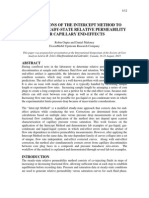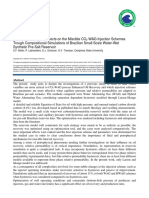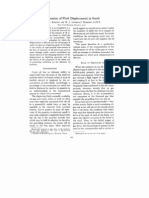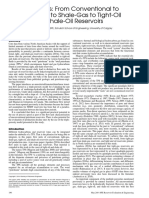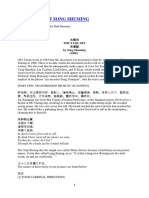SPE-172415-MS Advancement in Material Balance Analysis
SPE-172415-MS Advancement in Material Balance Analysis
Uploaded by
Amr HegazyCopyright:
Available Formats
SPE-172415-MS Advancement in Material Balance Analysis
SPE-172415-MS Advancement in Material Balance Analysis
Uploaded by
Amr HegazyOriginal Title
Copyright
Available Formats
Share this document
Did you find this document useful?
Is this content inappropriate?
Copyright:
Available Formats
SPE-172415-MS Advancement in Material Balance Analysis
SPE-172415-MS Advancement in Material Balance Analysis
Uploaded by
Amr HegazyCopyright:
Available Formats
SPE-172415-MS
Advancement in Material Balance Analysis
Austin Ukwu Kanu and Onyekonwu Mike Obi, Department of petroleum and Gas Engineering, Univeristy of Port
Harcourt, Nigeria
Copyright 2014, Society of Petroleum Engineers
This paper was prepared for presentation at the SPE Nigeria Annual International Conference and Exhibition held in Lagos, Nigeria, 05 07 August 2014.
This paper was selected for presentation by an SPE program committee following review of information contained in an abstract submitted by the author(s). Contents
of the paper have not been reviewed by the Society of Petroleum Engineers and are subject to correction by the author(s). The material does not necessarily reflect
any position of the Society of Petroleum Engineers, its officers, or members. Electronic reproduction, distribution, or storage of any part of this paper without the written
consent of the Society of Petroleum Engineers is prohibited. Permission to reproduce in print is restricted to an abstract of not more than 300 words; illustrations may
not be copied. The abstract must contain conspicuous acknowledgment of SPE copyright.
Abstract
The foremost objective of producing reservoir material balance analysis is to determine STOIIP and
aquifer properties which ensure that the aquifer influx into the reservoir reliably offsets production. But
the different views canvassed on this analysis are hampered by the limitation that the material balance
equation is an ill-posed pressure-implicit depletion function. So, this program has adopted a robust and
self-adaptive nonlinear regression to advance material balance analysis. The program validated two
examples and pointed out the shortcomings of the authors solutions.
Introduction
Many views have been canvassed on black oil material balance analysis to determine STOIIP for a
volumetric reservoir; and in the case of water drive reservoir, alongside aquifer influx1,2,3,4. It is evident
that STOIIP for a volumetric reservoir can be estimated uniquely1. This does not hold for a water drive
reservoir. When estimating water influx, aquifer properties such as thickness, permeability, compressibility, radius, porosity and encroachment angle are hardly ever known since wells are usually not drilled
into the aquifer. When these properties cannot be accurately defined, STOIIP is difficult to estimate
uniquely. This is because the solution to the material balance pressure-depletion function is not unique.
The nonuniqueness associated with water drive reservoir depletion problem crops up because of the
ill-posed nonlinear nature of water drive material balance equation. To remedy this problem, Havlena and
Odeh3 opt to replace such material balance pressure-depletion function by a well-posed linear function,
with a slope equal to aquifer constant and an intercept equal to STOIIP. Suffice it that this replacement,
even so it simplifies mathematics, is not only oblivious of the ill-condition of the material balance
pressure-depletion function but fails to preserve the physical meaning of material balance parameters.
Sill4 is of the opinion that nonlinear regression should be performed on the original material balance
pressure-depletion function to preserve the physical meaning of material balance variables. Sequel to this,
the study has developed a robust self-adaptive nonlinear regression program that would improve the
quality of material balance predictions. The choice of this method is inspired by the work of OReilly5
who developed a superb PVT package in the MATLAB software. By extension, it is reasoned that he
simply bought into the fitting capability of the nonlinear regression program intrinsic in MATLAB. This
is in lieu of the trial and error procedure as widely adopted by investigators like Dake1 and Olarewaju6.
SPE-172415-MS
The salient goal of this study is to build a material balance simulator that would advance the way and
manner material balance analysis is performed in the industry. The simulator program has adopted a
robust and self-adaptive nonlinear regression method. However, the study maintains that obtaining a
reasonable match is as eminent as obtaining physically practical results. Thus, as much as a reasonable
match is so desired, reservoir engineering application of the output must not be sacrificed.
Material balance analysis of course, cannot replace good engineering judgment and interpretation. In
some cases it can be exceptionally reliable while in others it can be nauseatingly deceptive. It is always
helpful to try it, if only to find out that it does not work, and why. But, it must be borne in mind that
whether the material balance analyst is honest or dishonest, clever or stupid, right or wrong, the reservoir
will always do what it ought to do.
Technical Overview
Material balance analysis is simply an inventory of all fluids entering, leaving, and remaining in the
reservoir. It is based on the principle of mass balance that: the amount of material (oil, gas and water)
remaining in the reservoir after a production interval is equal to the amount of material originally in the
reservoir minus the amount of material removed from the reservoir (because of production), plus the
amount of material added to the reservoir (because of injection and encroachment). This can be
generalized mathematically in the form called the general material balance equation as:
(1)
The material balance equation is a relationship between reservoir pore volume, average reservoir
pressure, and cumulative production from and injection into the reservoir. By recording cumulative
production and the average reservoir pressure over time, STOIIP can be estimated. But, the material
balance equation contains an unknown water influx term, which for all intent and purpose must be
completely described before any attempt to calculate STOIIP.
Here is the trouble. There is an inherent uncertainty in estimating the amount of water influx from the
aquifer to offset the reservoir pressure depletion. Van Everdingen and Hurst7 solved the diffusivity
equation (Equation 2) using the Laplace transformation to radial aquifer system under different assumptions to give the basic equations for estimating water influx as a function of time for different aquifer
radius.
(2)
The exact constant terminal pressure solution to Equation 2 for a closed outer boundary radial aquifer
system as presented by Van Everdingen and Hurst7 is
(3)
The aquifer constant and dimensionless time are defined by Equations 4 and 5 as follow:
(4)
(5)
Equation 3 is meant to compute cumulative water influx for an instantaneous pressure decline at the
reservoir-aquifer boundary. This instantaneous pressure decline can be replaced by a number of constant
pressure steps (see Equation 6) and the superposition of the series of influxes with time yields the
cumulative water influx8.
SPE-172415-MS
(6a)
(6b)
Carter and Tracy9 rather than use a constant
pressure terminal boundary condition assumed a
constant terminal rate boundary condition for each
time-step to solve the diffusivity equation (Equation
2) for water influx. Good enough, this assumption
eliminates the Van Everdingen and Hurst superposition principle, which suppose, there are no type of
high speed computers present today is a tedious
manual computation. Carter and Tracy9 proposed
their water influx solution as
Figure 1Material Balance Analysis Workflow
(7)
The aquifer constant B and the dimensionless time tDn are defined in Equations 4 and 5.
Carter-Tracy technique is not an exact solution to the diffusivity equation, but an approximation. It
therefore approximates the Van Everdingen and Hurst method, provided the time step is restricted as
infinitesimal as practicable. But then, what is the practicability of obtaining average reservoir pressure at
such infinitesimal time step?
Estimating water influx requires multiple values of dimensionless water influx WeD for the Van
Everdingen and Hurst constant terminal pressure solution or dimensionless pressure PD for the CarterTracy constant terminal rate solution. Traditionally, two approaches have been developed to accomplish
this: the table lookup and the graphical analysis with their attendant interpolation severity between time
entries. Indeed, both approaches are further flawed by speed, storage, and most importantly accuracy.
Consequently, Klins et al10 presented 4 sets of simple polynomials that are easy to implement to obtain
accurate values of WeD or PD for either the finite or infinite aquifer.
Proposed Methodology
The method of material balance analysis adopted by the study follows the workflow shown in Figure 1
The entire workflow seeks to
completely define the reservoir fluid
evaluate volume of water influx into the reservoir from the aquifer
estimate stock-tank initial oil in place and as well characterize aquifer parameters
PVT Model
PVT fluid modeling is generally performed either in black-oil formulation, as supported by this program,
or in equation of state mode. The black-oil formulation mode employs statistical models in the form of
correlations. There are varieties of black oil PVT correlations. Some have received higher attention and
wider acceptability than others11. Some have shown their reliability in various comparative studies based
on regions and data range12.
This study employs six correlations: Standing13, Lasater14, Glaso15, Al-Marhoun16, Petrosky-Fashad17
and Vazques-Beggs18 to calculate solution GOR and oil FVF. The solution GOR formulation is usually
derived from the bubble point correlation. Each of these correlations like others used data of certain
regions hence, their application is limited19,20,21. However, with measured PVT data, the program
SPE-172415-MS
presented the option of the globalize versions of these correlations by removing the local constraints
imposed on them and improve their predictive capabilities for all oil compositions, reservoir temperature
and pressure. The gas FVF is computed from the real gas equation of state. There is option to enter the
PVT properties manually.
Aquifer Model
The study provides the facility to compute water influx directly from the geological estimate of aquifer
properties. It has been established that the Van Everdingen and Hurst aquifer model is the most accurate
model, hence its wide acceptability. The advances in computer operating capability have reduced the
calculation complexity associated with Van Everdingen and Hurst superposition to a very traceable one.
Material Balance Regression
Combining the fluid description and aquifer models, the cumulative production is regressed nonlinearly
on the average reservoir pressure unswervingly in Equation 1. The nonlinear regression is based on
Levenberg-Marquardt algorithm, which on one hand is perceived as a blend of Vanilla steepest descent
and Gauss-Newton iteration, and on the other as a trust-region algorithm22,23,24. Whichever perspective
the Levenberg-Marquardt algorithm is viewed, the tuning objective is to find the argument that minimizes
the sum of the squares of the errors between the cumulative production history and the pressure-depletion
function to achieve a reasonable match.
of an independent pressure variable p and a vector
In fitting a cumulative production function
of m regression constants c to a set of n production history (p,Np), the objective is to find the update
where F(c) is the Euclidian norm defined by
(8)
The residues at every pressure point is given by Equation 9
(9)
The weighting factor defined by
(10)
Here, the vector of m regression constants c represents the vector with elements STOIIP and aquifer
parameters such as permeability, porosity, encroachment angle, and reservoir-aquifer ratio. Starting with
the current values of the regression constants ci, the target is to find the perturbations or steps h from
Equation 11
(11)
which when added to the current regression constants would give new regression constants ci1 as
(12)
These new regression constants are hopefully better minimization arguments of the objective function.
Before the system of linear equations (Equation 11) is solved, it is demanding to examine each matrix term
carefully.
Provided that the weighted residuals are small, the Hessian matrix H need not be evaluated exactly but
can be approximated essentially by Equation 13
SPE-172415-MS
(13)
where the Jacobian is computed thus:
(14)
It follows from Equation 13 that the Hessian matrix is a symmetric matrix. The term diag(H) is used
to penalize large perturbations.
The damping factor is always greater than zero which guarantees that H diag(H) is a positive
definite matrix and ensures that the steps are always in the descent direction. This property of H
diag(H) ensures that QR decomposition with Gram-Schmidt orthogonalization process yields a numerically stable solution to the linear systems of Equation 11. Q is the orthogonal matrix of H diag(H) and
R is the Cholesky factor representing a non-singular upper triangular matrix. However, the QR decomposition process is about twice as expensive as Gauss elimination process and LU decomposition with or
without pivoting.
The damping factor also influences both the direction and size of the step. If the error goes down
following an update, is reduced and the algorithm degenerates to Gauss-Newton update. On the
contrary, if the error amplifies following an update, is increased and the update becomes gradient
descent iteration. The update is controlled by the gain-ratio given by
(14)
If the gain-ratio is greater than zero then the current update is a good approximation and the damping
factor is decreased so that the next Levenberg-Marquardt step is closer to the Gauss-Newton step. If the
gain-ratio is less than zero then the current update is a poor approximation and the damping factor is
increased with the twofold aim of getting next Levenberg-Marquardt step closer to the steepest descent
direction and reducing the step size.
Validation Example 1
The program validated Dakes1 Example 9.2, page 310 319. This example was also used by Petroleum
Expert25 to verify their MBAL regression codes. The worksheet to view the program is called the
AquiferInflux worksheet which is composed of the Aquifer and Reservoir Parameters dialog,
Estimated Hurst-Van Water Influx dialog, Production and PVT Data dialog and Prod Data Regress
dialog (see Figure 2).
The example is based on a wedged shaped saturated reservoir with fairly strong natural water drive. It
was initially suspected, based on seismic and geological evidence that the aquifer properties and STOIIP
are as given in column C of Aquifer and Reservoir Parameters dialog of Figure 2. In this example,
Dakes objective was to determine the aquifer extent, aquifer influx and STOIIP. To this limited extent,
he correctly preempted most of the rather uncertain aquifer properties (except rD) and STOIIP.
For rD 10 and based on 10 years pressure history (see columns F and G of Estimated Hurst-Van
Water Influx dialog), Dake calculated the water influx using the unsteady state theory of van Everdingen
and Hurst. The program has an inbuilt subroutine (which is activated by clicking on Estimate Water
Influx button) to exactly reproduce the van Everdingen and Hurst technique in columns H to K of
Estimated Hurst-Van Water Influx dialog. The outputs of the program accurately agree with the Dakes
results.
Next, with the computed water influx at rD 10 Dake1 applied the straight line material balance
analysis technique of Havlena and Odeh3 and observed that the plot F/Eo versus We/Eo deviates below the
theoretical unit slope line after the first year, indicating that the correct value of rD should be less than 10.
SPE-172415-MS
Figure 2Worksheet Interface for Example 1
Figure 3Aquifer Fitting Using the Interpretation Technique of Havlena and Odeh (Dake, 1978, pg 319)
He then repeated the same calculation with rD 5, and observed that all the points lie on the straight line
of unit slope which intercepts the ordinate at Np 312 MMstb (see Figure 3).
The solution is correct but faces two shortcomings. One, it is practically impossible to guess by trial
and error, the correct value of rD that would give a reasonable match of the material balance equation with
production history. Two, the method assumed that other aquifer properties except rD are accurate
representation of the aquifer and as such do not influence the match.
SPE-172415-MS
Figure 4 Material Balance Matching for Example 1
Table 1PVT Properties (Ezekwe, page 268)
Being aware that the technique of Havlena and
3
Pressure
Bo
Rs
Odeh as applied by Dake ignored the size of the
[Psia]
[rb/stb]
[Scf/stb]
effect of other aquifer properties other than rD, the
10535
1.552
1417
study regressed (by clicking on MBE Analysis
10000
1.561
1417
button shown in Figure 2) the pressure-production
9500
1.568
1417
function with respect to all aquifer properties and
9000
1.576
1417
STOIIP to accurately and adequately define STOIIP
8500
1.584
1417
8104
1.592
1417
and aquifer parameters. The regression outputs are
within acceptable limits of the seismic and geologic
evidence as reported by Dake (see column D of
Aquifer and Reservoir Parameters dialog of Figure 2). The programs STOIIP is 312.2275 MMstb and
rD is 5.25 as against Dakes estimated STOIIP of 312 MMstb and rD of 5. It follows then that the seismic
and geologic estimates are reasonable initializations to the material balance regression analysis.
Finally, Dake returned the cumulative aquifer influx at rD 5 that would balance the 10 years
production history. His results compares reasonably with the programs output as shown column U of
Prod Data Regress dialog of Figure 2. The regressed cumulative oil production over the 10 year period
is shown in column V of Prod Data Regress dialog and compared with the cumulative production
history in Figure 4.
Validation Example 2
The second example validated by the program is taken from Ezekwes2 Example 9.2, page 268 276. The
example concerns undersaturated reservoir with water influx. The worksheet to view the program is
similar to that of example 1 (see Figure 5). The PVT properties are presented in Table 1, and the aquifer
and reservoir properties are given in Table 2.
In this example, Ezekwes intention was to determine the aquifer influx and STOIIP. He consequently
assumed that the aquifer is infinite-acting and calculated the cumulative water influx using the CarterTracy method with Edwardson et al dimensionless pressure polynomials. To initialize the programs
SPE-172415-MS
Figure 5Worksheet Interface for Example 2
STOIIP, initial oil FVF (Table 1) is combined with the aquifer and reservoir properties (Table 2) in the
following volumetric equation to give STOIIP 12.29 MMstb.
(15)
The production data corresponding to the date and pressure in columns E and G of Estimated
Hurst-Van Water Influx dialog in Figure 5 as presented by Ezekwe is given in columns M, N and T of
Prod Data Regress dialog. One observation is that PVT experiment is not always performed for all
pressure history during depletion, but for some selected pressure points (see Table 1) between the initial
and current reservoir pressure. So to evaluate PVT properties for the pressure history, Ezekwe plotted the
PVT experiment in Excel Sheet and curve fitted it with the polynomial given by:
SPE-172415-MS
Table 2Aquifer and Reservoir Properties (Ezekwe, page 268)
Figure 6 Material Balance Matching for Example 2
(16)
Even so, this type of problem is more of interpolation than curve fitting. Thus, the program is equipped
with a cubic-spline subroutine that interpolates between the initial and current pressures to give the PVT
properties for all the pressure history during depletion. Take for instance oil FVF for November 1, 2003,
10
SPE-172415-MS
Ezekwe computed oil FVF from Equation 16 as 1.5560 rb/stb while the programs oil FVF is 1.56374
rb/stb as shown in cell O9 of Figure 5.
Finally, Ezekwe initiated the straight line material balance analysis technique of Havlena and Odeh3
and showed that the STOIIP is 21.5 MMstb as against the geologic STOIIP of 21 MMstb. Keeping faith
with the programs fitting capability; the studys STOIIP is 20.55529 MMstb with rD 2.6. The regressed
cumulative oil production is compared with the cumulative production history in Figure 6.
Figure 6 as well as Ezekwes Havlena and Odeh plot showed a poor match which he provided an
explanation for. Ezekwe2 pointed that that there might have been instability of production data during the
early stage of production (June to October, 2003). At the late production time (May to August, 2005), the
variability of the data is caused by constant formation compressibility2.
Conclusions
A Levenberg-Marquardt nonlinear regression algorithm was implemented to estimate STOIIP and aquifer
properties from material balance equation. The idea was to tune the material balance equation to match
historical production by varying STOIIP and aquifer properties. The program was used to validate 2
production scenarios from literature: one producing below bubble point and the other above bubble point.
The procedure used in this program also accounted for some aquifer parameters such as compressibility,
permeability, porosity, thickness and enchroachment angle.
Nomenclature
B
aquifer constant, rb/psi
gas FVF, rb/stb
Bg
water FVF, rb/stb
Bw
total compressibility, psi-1
ct
cfw
formation compressibility, psi-1
cw
water compressibility, psi-1
Et
total expansion due to oil and dissolved gas, free gas and formation, rb/stb
F
cumulative reservoir voidage, rb
FVF
formation volume factor, rb/stb
gas injection, MMscf
Gi
GOR
gas-oil ratio, scf/stb
aquifer thikness, ft
hw
aquifer permeability, md
kw
N
stock-tank oil initial in place, stb
p
pressure, psi
p
pressure change, psi
r
radius, ft
dimensionless radius
rD
reservoir radius, ft
ro
STOIIP stock-tank oil initial in place, stb
t
time, hr
dimensionless time
tD
water influx, rb
We
dimensionless water influx
WeD
water injection, stb
Wi
w
water porosity
w
water viscosity, cp
SPE-172415-MS
11
enchrochment angle
Refrences
1. Dake, L. P.: Fundamentals of Reservoir Engineering, Elsevier Science Publishing, New York,
page 310 335, 1978
2. Ezekwe, N.: Petroleum Reservoir Engineering Practice, Prentice Hall, Boston, page 255293,
2011
3. Havlena, D. and Odah, A. S.: The Material Balance as an Equation of a Straight Line, J. Pet
Tech, Trans., AIME, 896 900, August, 1963
4. Sill, S. R.: Improved Material Balance Regression Analysis for Waterdrive Oil and Gas
Reservoirs, SPE-28630, Paper presented at New Orleans Annual Technical Conference and
Exhibition, Sept.2528, 1989
5. OReilly D. I.: Comparative PVT Simulation: An Application to Australasian Fluid Samples,
SPE-129517-STU, Paper presented at New Orleans Annual Technical Conference and Exhibition,
Oct. 4 7, 2009
6. Olarewaju, J. S.: A Mathematical Model of Edgewater and Bottomwater Drives for Water Influx
Calculations, SPE-18764, Paper presented at California Regional Meeting, April 57, 1989
7. van Everdingen, A. F. and Hurst, W.: The Application of Laplace Transformation to Flow
Problems in Reservoirs, J. pet. Tech., Tans. AIME, 305324, December, 1949
8. Archer, J. S. and Wall, C. G.: Petroleum Engineering: Principles and Practice, Graham and
Trotman ltd, London, 1986.
9. Carter, R. D. and Tracy, G. W.: An Improved Method of Calcualting Water Infux, Trans AIME,
1960.
10. Klins, M. A.; Bouchard, A. J. and Cable, C. L.: A Polynomial Approach to the Van EverdingenHurst Dimensionless Variables for Water Encroachment, SPE 15433, Paper presented at New
Orleans Annual Technical Conference and Exhibition, Oct 5 8, 1988
11. Ali D.: PVT and Phase Behavoiur of Petroleum Reservoir Fluids, Elsevier Science B. V.,
Amsterdam, 1998.
12. De Ghetto, G.; Paone, F. and Villa, M.: Reliability Analysis on PVT Correlations, SPE 28904,
Presented at the European Conference, London, 25 27 October, 1994.
13. Standing, M. B.: A Pressure-Volume-Temperature for Mixtures of California Oils and Gases,
Presented at the spring meeting of the Pacific Coast District, Division of Production, Los Angeles,
California, May 16, 1947.
14. Lasater, J. A.: Bubble Point Pressure Correlation, SPE 957-G, Trans AIME, p. 6557, may,
1958.
15. Glaso, O.: generalized Pressure-Volume-Temperature Correlations, SPE 8016, JPT, p. 785
795, May, 1980.
16. Al-Marhoun, M. A.: PVT Correlations for Middle East Crude Oils, SPE 13718, JPT, p.
650 666, May, 1988.
17. Petrosky, G. E. and Farshad, F.: Pressure-Volume-temperature Correlations for Gulf of Mexico
Crude Oils, SPE 51395, Presented at the SPE Annual Technical Conference and Exhibition,
Houston, JPT, p. 416 420, 3 6 October, 1993.
18. Vasquez, M. E. and begs, H. D.: Correlation for Fluid Physical Property Predictions, JPT, p.
968 970, June, 1980
19. McCain, W. D.: The properties of Petroleum Fluids, 2nd edition, PennWell Books, Tulsa,
Oklahoma, 1990.
20. Ahmed, T.: Reservoir Engineering Handbook, 2nd edition, Gulf Publishing Company, Texas,
2001
12
SPE-172415-MS
21. Whitson, C. H. and Brule, M. R.: Phase Behaviour, SPE Inc., Taxas, 2000.
22. Madsen, K. H. B. and Nielsen O. T.: Methods for Nonlinear Least Squares Problems,
Informatics and Mathematics Modelling Technical University, Denmark, April 2004
23. Henri, P. G.: The Levenberg-Marquardt Method for Nonlinear Least Squares Curve-Fitting
Problems, Department of Civil and Environmental Engineering, Duke University, October 2013
24. Christian, K.; Nobuo, Y. and Masao, F.: Levenberg-Marquardt Methods for Constrained Nonlinear Equations with Strong Local Convergence Properties, Ministry of Education, Science,
Sport and Culture, Japan, 2002
25. Petroleum Expert: MBAL User Guide, IPM, Version 10.5, pp 454 466, January, 2010
26. Amyx, J. W.; Bass, D. M.Jr. and Whiting, R. L.: Petroleum Reservoir Engineering: Physical
Properties, McGraw-Hill Inc., New York, Reissued, 1988.
27. Ananth, R.: The Levenberg-Marquardt Algorithm, 2004
28. Chapra, S. C. and Canale, R. P.: Numerical Methods for Engineers, 3rd edition, McGraw-Hill,
New York, page 468 471, 1998.
29. Craft, B. C. and Hawkins, M. F.: Applied Petroleum Reservoir Engineering, 2nd edition, Prentice
Hall Inc., EagleWood Cliffs, New Jersey, 1991.
30. Curtis, F. G. and Patrick O. W.: Applied Numerical Analysis, 7th Edition, Pearson Education Inc.,
Boston, 2004
31. Francisco, J. B.; Krejic, N. and Martinez, J. M.: An Interior-Point Method for Solving BoxConstrained Undetermined Nonlinear System, Department of Applied Mathematics, University
of Campinas, Brazil, 2004
32. Jonathan, M. B.: A Bound-Constrained Levernberg-Marquardt Algorithm for a Parameter
Identification Problem in Electromagnetics
33. Noamam, A. F.: Estimation of Aquifer Parameters Using the Numerical Inversion of Laplace
Transform, SPE 81428, Paper presented at 13th Bahrain Middle East Oil Show Meeting, April
5 8, 2003
You might also like
- English For NursingDocument16 pagesEnglish For NursingMaria Apostu StylesNo ratings yet
- SPE-22350-PA - Integrated Reservoir Management PDFDocument8 pagesSPE-22350-PA - Integrated Reservoir Management PDFPedroNo ratings yet
- Useful Concepts For Decline-Curve Forecasting, Reserve Estimation, and AnalysisDocument10 pagesUseful Concepts For Decline-Curve Forecasting, Reserve Estimation, and AnalysisExpert_ModellerNo ratings yet
- Sonic Scanner PPT Compatibility ModeDocument29 pagesSonic Scanner PPT Compatibility ModeAmr Hegazy100% (1)
- Credential E-Faktur H2H Telkompajakku PDFDocument17 pagesCredential E-Faktur H2H Telkompajakku PDFEnda JuandaNo ratings yet
- Level 1 and WOCRM User Guide 2Document7 pagesLevel 1 and WOCRM User Guide 2adityamduttaNo ratings yet
- EIM GRADE 9 10 Q4 Module 1b - National Electrical Code NEC Provisions in Installing Wiring Devices - GFCI. - FinalDocument23 pagesEIM GRADE 9 10 Q4 Module 1b - National Electrical Code NEC Provisions in Installing Wiring Devices - GFCI. - FinalTitser Ramca100% (3)
- Naive Ba YesDocument5 pagesNaive Ba Yeslubna_java2858No ratings yet
- Reservoir Management For Waterfloods R. Baker: This Article Begins On The Next PageDocument6 pagesReservoir Management For Waterfloods R. Baker: This Article Begins On The Next PageHichem FakhfekhNo ratings yet
- SCA 2015 Technical PapersDocument561 pagesSCA 2015 Technical PaperschikukotwalNo ratings yet
- DC Final FormDocument21 pagesDC Final FormSoz Ahmed100% (1)
- Analysis Decline Curve IngleDocument13 pagesAnalysis Decline Curve Ingleaminta26100% (1)
- SPE 9710 Screening Tests For Enhanced Oil Recovery ProjectsDocument15 pagesSPE 9710 Screening Tests For Enhanced Oil Recovery ProjectsCarlos David ObandoNo ratings yet
- How To Perform A Type Curve Analysis SPE84472Document14 pagesHow To Perform A Type Curve Analysis SPE84472hijoetigreNo ratings yet
- Dca PPT For Oist-200214Document30 pagesDca PPT For Oist-200214Sikander Mushtaq100% (1)
- Reserve Estimation Methods 04 MB1Document10 pagesReserve Estimation Methods 04 MB1siriuslotNo ratings yet
- Traditional Decline Curve AnalysisDocument5 pagesTraditional Decline Curve AnalysisWilliam AmpomahNo ratings yet
- Discharge Stimulation of Geothermal Wells Overview and AnalysisDocument21 pagesDischarge Stimulation of Geothermal Wells Overview and AnalysisNurrahmisrNo ratings yet
- Warrlich Et Al., 2019 (AAPG)Document31 pagesWarrlich Et Al., 2019 (AAPG)redwanasisNo ratings yet
- PZ Analysis of A Mature Gas Condensate Field, Offshore TrinidadDocument15 pagesPZ Analysis of A Mature Gas Condensate Field, Offshore TrinidadMarcochristianNo ratings yet
- Analyzing Well Production Data Using Combined-Type-Curve and Decline-Curve Analysis ConceptsDocument9 pagesAnalyzing Well Production Data Using Combined-Type-Curve and Decline-Curve Analysis ConceptsDull MárquezNo ratings yet
- SPE30714 Fevang WhitsonDocument16 pagesSPE30714 Fevang WhitsonMohamed El KikiNo ratings yet
- 10 11648 J Ijsts 20150302 14 PDFDocument10 pages10 11648 J Ijsts 20150302 14 PDFBagus SetyaNo ratings yet
- Linear DisplacementDocument22 pagesLinear DisplacementFlorian Ananias ByarugabaNo ratings yet
- SPE-35698-PA Kuparuk Large Scale Enhanced Oil Recovery ProjectDocument10 pagesSPE-35698-PA Kuparuk Large Scale Enhanced Oil Recovery ProjectGilbert Omitta100% (1)
- Equilibrium Ratio Prediction and CalculationDocument28 pagesEquilibrium Ratio Prediction and CalculationweldsvNo ratings yet
- Streamline Technology Reservoir History Matching and Forecasting PDFDocument5 pagesStreamline Technology Reservoir History Matching and Forecasting PDFTheNourEldenNo ratings yet
- SPE-193121-MS - Integrated Prod Optim Workflow Provides Robust Platform For Significant Oil Gain To A Mature Field-UnlockedDocument22 pagesSPE-193121-MS - Integrated Prod Optim Workflow Provides Robust Platform For Significant Oil Gain To A Mature Field-UnlockedadeeyoNo ratings yet
- RESERVES SimulacionDocument39 pagesRESERVES SimulacionJoy FaruzNo ratings yet
- Calculation OfCumulative Water Influx Using Van-Everdingen Model With Superposition Concept by MATLAB ProgramDocument48 pagesCalculation OfCumulative Water Influx Using Van-Everdingen Model With Superposition Concept by MATLAB ProgramAlberto MoroNo ratings yet
- 22 - Relative Permeability Effects On The Miscible CO2 WAG Injection SchemesDocument9 pages22 - Relative Permeability Effects On The Miscible CO2 WAG Injection SchemesheviNo ratings yet
- DDocument15 pagesDJuan Lopez100% (2)
- SPE 130768 Multi-Field Asset Integrated Optimization BenchmarkDocument19 pagesSPE 130768 Multi-Field Asset Integrated Optimization BenchmarkIndo UtamaNo ratings yet
- Paper Decline Curve Analysis 1 (Najib)Document16 pagesPaper Decline Curve Analysis 1 (Najib)Ichsan Al Sabah LukmanNo ratings yet
- SPE-185428-MS Optimizing Cost and Effectiveness of Well Interventions: An Holistic ApproachDocument17 pagesSPE-185428-MS Optimizing Cost and Effectiveness of Well Interventions: An Holistic ApproachQaiser HafeezNo ratings yet
- Kal War 2017Document10 pagesKal War 2017khusnul9No ratings yet
- ESP Diagnostic With ExercisesDocument28 pagesESP Diagnostic With ExercisesReza RamadhanNo ratings yet
- Definitions ReserveDocument13 pagesDefinitions Reservejoo123456789No ratings yet
- Managing DeclineDocument21 pagesManaging Declinerahulme43No ratings yet
- 1.1 Well Testing and The Ideal Reservoir ModelDocument12 pages1.1 Well Testing and The Ideal Reservoir ModelLuffy01100% (1)
- Analyzing Well Production Data by Use of Combined Type-Curve-And Decline-Curve-Analysis ConceptsDocument2 pagesAnalyzing Well Production Data by Use of Combined Type-Curve-And Decline-Curve-Analysis Conceptsnicolascm94No ratings yet
- Design Considerations When Rod Pumping Gas WellsDocument12 pagesDesign Considerations When Rod Pumping Gas Wellssurakhi2011No ratings yet
- Blasingame Decline Type CurveDocument6 pagesBlasingame Decline Type Curvecamelion3No ratings yet
- Capillary Pressure and Relative Permeability Correlations For Transition Zones of Carbonate Reservoirs PDFDocument18 pagesCapillary Pressure and Relative Permeability Correlations For Transition Zones of Carbonate Reservoirs PDFDamir986No ratings yet
- Buckley, S.E. and Leverett, M.C. Mechanism of Fluid Displacement in SandsDocument10 pagesBuckley, S.E. and Leverett, M.C. Mechanism of Fluid Displacement in SandsSolenti D'nouNo ratings yet
- 762id - Development of Cluster-7 Marginal Field Paper To PetrotechDocument2 pages762id - Development of Cluster-7 Marginal Field Paper To PetrotechSATRIONo ratings yet
- Scal For Gas Reservoirs: A Contribution For Better ExperimentsDocument13 pagesScal For Gas Reservoirs: A Contribution For Better ExperimentsMustapha Bouregaa100% (1)
- Hesham Mokhtar Ali Senior Reservoir Engineer 2021: In/heshammokhtaraliDocument7 pagesHesham Mokhtar Ali Senior Reservoir Engineer 2021: In/heshammokhtaraliAlamen GandelaNo ratings yet
- Optimizing Water Inj Rate For Waterflooding FieldDocument1 pageOptimizing Water Inj Rate For Waterflooding FieldAnnisa Arisyi50% (2)
- Aguilera 2014Document19 pagesAguilera 2014rafaelNo ratings yet
- SPE-28589 Merril and Hartman A Comparison of Equation of State Tuning MethodsDocument16 pagesSPE-28589 Merril and Hartman A Comparison of Equation of State Tuning MethodsSolenti D'nouNo ratings yet
- Otc 22963Document14 pagesOtc 22963Rasheed YusufNo ratings yet
- Decline-Curve Analysis For Gas WellsDocument40 pagesDecline-Curve Analysis For Gas WellsjangojangoNo ratings yet
- Eni Wta 3Document93 pagesEni Wta 3Ahmed RaafatNo ratings yet
- A Continuous and Dynamic Production Allocation Method For Commingled Gas Wells Using An Arithmetic Progression ApproachDocument13 pagesA Continuous and Dynamic Production Allocation Method For Commingled Gas Wells Using An Arithmetic Progression ApproachKasanto22No ratings yet
- PETSOC 09-07-18.PDF Gas Condensate Reservoir PerformanceDocument7 pagesPETSOC 09-07-18.PDF Gas Condensate Reservoir Performanceswaala4real0% (1)
- Dynamic Material Balance Oil or Gas in Place Without ShutInsDocument6 pagesDynamic Material Balance Oil or Gas in Place Without ShutInsMUHAMMED FUADNo ratings yet
- Curtis H. WhitsonDocument18 pagesCurtis H. WhitsonglsancorNo ratings yet
- Water Influx 1Document43 pagesWater Influx 1ChoiriahAgustinaSaritikaPutrianiNo ratings yet
- Pro Tech 1 CH 2Document29 pagesPro Tech 1 CH 2weldsvNo ratings yet
- Principles of Well SpacingDocument18 pagesPrinciples of Well SpacingbellebelalNo ratings yet
- Ep Petrochina MangroveDocument3 pagesEp Petrochina MangroveStiveGrajalesNo ratings yet
- Reservoir Engineering of Conventional and Unconventional Petroleum ResourcesFrom EverandReservoir Engineering of Conventional and Unconventional Petroleum ResourcesNo ratings yet
- Perforation DamageDocument10 pagesPerforation DamageAmr Hegazy0% (1)
- Isolation ScannerDocument8 pagesIsolation ScannerAmr HegazyNo ratings yet
- Material-Balance-Time During Linear and Radial Flow: Petroleum SocietyDocument16 pagesMaterial-Balance-Time During Linear and Radial Flow: Petroleum SocietyAmr HegazyNo ratings yet
- Pressure Inversion and Material Balance Calculations: Technical Note'Document3 pagesPressure Inversion and Material Balance Calculations: Technical Note'Amr HegazyNo ratings yet
- SPE 114044 A Quadratic Cumulative Production Model For The Material Balance of An Abnormally Pressured Gas ReservoirDocument33 pagesSPE 114044 A Quadratic Cumulative Production Model For The Material Balance of An Abnormally Pressured Gas ReservoirAmr HegazyNo ratings yet
- Spe 26244 MS PDFDocument13 pagesSpe 26244 MS PDFAmr HegazyNo ratings yet
- Advanced Gas Material Balance in Simplified Format: S. Moghadam, O. Jeje, and L. Mattar, Fekete Associates IncDocument9 pagesAdvanced Gas Material Balance in Simplified Format: S. Moghadam, O. Jeje, and L. Mattar, Fekete Associates IncAmr HegazyNo ratings yet
- Spe 49225 MSDocument9 pagesSpe 49225 MSAmr HegazyNo ratings yet
- SPE 56690 Analysis of Overpressured Reservoirs With A New Material Balance MethodDocument14 pagesSPE 56690 Analysis of Overpressured Reservoirs With A New Material Balance MethodAmr HegazyNo ratings yet
- The Flowing Material Balance Procedure L. Mattar R. Mcneil: This Article Begins On The Next PageDocument14 pagesThe Flowing Material Balance Procedure L. Mattar R. Mcneil: This Article Begins On The Next PageAmr HegazyNo ratings yet
- "Evaluation of Material Balance Analysis Methods For Volumetric, Abnormally-Pressured Gas Reserviors" A.K. AmbasthaDocument7 pages"Evaluation of Material Balance Analysis Methods For Volumetric, Abnormally-Pressured Gas Reserviors" A.K. AmbasthaAmr HegazyNo ratings yet
- Nitrosaminas em Preservativos e BalõesDocument4 pagesNitrosaminas em Preservativos e BalõeseveltoncNo ratings yet
- UNSPSC Business Category and Family CodesDocument13 pagesUNSPSC Business Category and Family CodesvipinchawlaNo ratings yet
- Inmarsat Vocality Radio Over IPDocument8 pagesInmarsat Vocality Radio Over IPJorge CasaliNo ratings yet
- Non Peza ClientsDocument15 pagesNon Peza ClientsDioscoro J. Jebulan100% (1)
- JD 5 Relay CatalogDocument3 pagesJD 5 Relay Catalogjimmy barusNo ratings yet
- Meter L&TDocument12 pagesMeter L&TnenusakNo ratings yet
- Safe Handling of Hazardous ChemicalsDocument2 pagesSafe Handling of Hazardous ChemicalsFilipNo ratings yet
- GMP Implementation and CCP Determination On ChocolDocument10 pagesGMP Implementation and CCP Determination On ChocolFuji KusumaNo ratings yet
- Srisailam HPSDocument4 pagesSrisailam HPSN. Sasidhar100% (1)
- Teachings of Song ShumingDocument21 pagesTeachings of Song ShumingGladys SouzaNo ratings yet
- Components: Hitec® 536Document2 pagesComponents: Hitec® 536Liliana RodriguezNo ratings yet
- Reid™ SwiftLift™ Foot Anchors AS3850-2015 ComplianceDocument4 pagesReid™ SwiftLift™ Foot Anchors AS3850-2015 ComplianceAdamMitchellNo ratings yet
- Two Wheeler Policy PDFDocument4 pagesTwo Wheeler Policy PDFmankkaaNo ratings yet
- Monopoles and Electricity: Lawrence J. Wippler Little Falls, MN United StatesDocument9 pagesMonopoles and Electricity: Lawrence J. Wippler Little Falls, MN United Stateswaqar mohsinNo ratings yet
- Chap 3.7 Seagrass EcosystemDocument96 pagesChap 3.7 Seagrass Ecosystemsuganya rameshNo ratings yet
- Dokumen - Tips Ikhwan Al Safa Omar A Farrukh AskdryahyacomwwwaskdryahyacomrasailikhwansafapdfpdfDocument72 pagesDokumen - Tips Ikhwan Al Safa Omar A Farrukh Askdryahyacomwwwaskdryahyacomrasailikhwansafapdfpdfaxlduk12No ratings yet
- WPCE Enviro™ Wireline Grease Injection Control HeadDocument2 pagesWPCE Enviro™ Wireline Grease Injection Control HeadwillyrozoNo ratings yet
- Gas Turbine Meter User ManualDocument24 pagesGas Turbine Meter User Manualtsarayuth1.2017No ratings yet
- OperationalDescription - ST500 - SB - REV1.2 - 20161201.F.H.DE SOUZA - RASTREADORES - ME - Marked PDFDocument75 pagesOperationalDescription - ST500 - SB - REV1.2 - 20161201.F.H.DE SOUZA - RASTREADORES - ME - Marked PDFrichardNo ratings yet
- Mechanical Engineering Manufacturing.149Document1 pageMechanical Engineering Manufacturing.149Anonymous QvIxEazXGdNo ratings yet
- Physical Pharmacy Lab - Post LabsDocument90 pagesPhysical Pharmacy Lab - Post LabsFlorence Lynn BaisacNo ratings yet
- Datsun Blue Bird Parts Catalog 410 411 1964 68Document20 pagesDatsun Blue Bird Parts Catalog 410 411 1964 68andrea100% (62)
- Use of Steel Slag As Coarse Aggregate For The Production of Pervious ConcreteDocument11 pagesUse of Steel Slag As Coarse Aggregate For The Production of Pervious ConcretemargarethsmNo ratings yet
- 2008 NRL ReviewDocument250 pages2008 NRL ReviewU.S. Naval Research LaboratoryNo ratings yet
- Barhorst Cates2018Document24 pagesBarhorst Cates2018486521366987qNo ratings yet









